Commonly used linux commands
Commonly used Linux commands are: 1. cd command, used to switch directories; 2. ls command, used to display the contents of the specified working directory; 3. pwd command, used to display the location of the working directory; 4. mkdir command, used to create directories; 5. cp command, used to copy files or directories, etc.

I believe that many development and operation and maintenance are using the Linux operating system, because most servers are liunx systems.
The directory structure of Linux is a tree structure. The top-level directory is the root directory /. Other directories can be added to the tree by mounting and removed by unmounting.
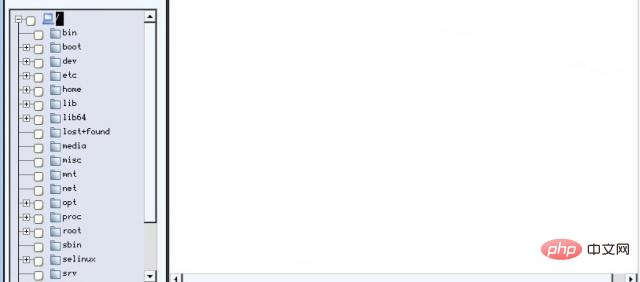
Let us learn about the commonly used file directory operation commands:
Related recommendations: "Linux Video Tutorial"
cd
#change directory, switch directory
Relative path: refer to the current directory to search, such as:
cd ../usr/local/src/
Absolute path: from the root Start specifying the directory and search recursively one level at a time. In any directory, you can enter the specified location, such as: cd /etc/
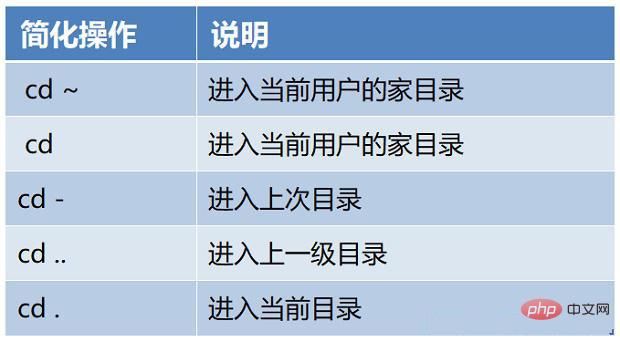
ls
Used to display the contents of the specified working directory (without parameters, the contents of the current directory will be listed.
Syntax:
ls [选项] [文件或目录]
Example:
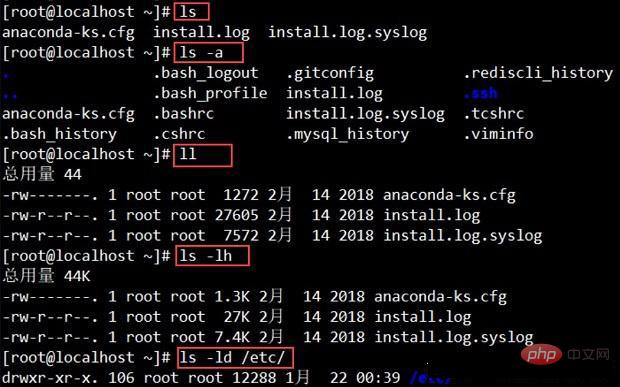
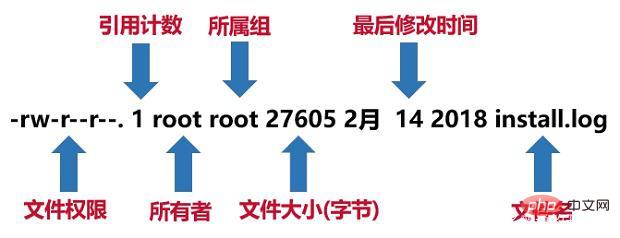
-rw-r--r--. Indicates that the owner of the file has read and write permissions, and the group and others have only read permissions. (" ."Represents ACL permissions)
pwd
Displays the location of the working directory (displays the absolute path)
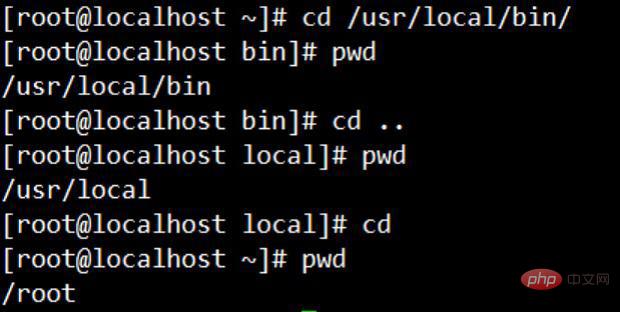
mkdir
Create a directory, -p creates recursively, used to create multi-level directories
Syntax:
mkdir -p [目录名]

cp
copy, copy files or directories
Syntax:
cp [选项] [原文件或目录] [目标目录]
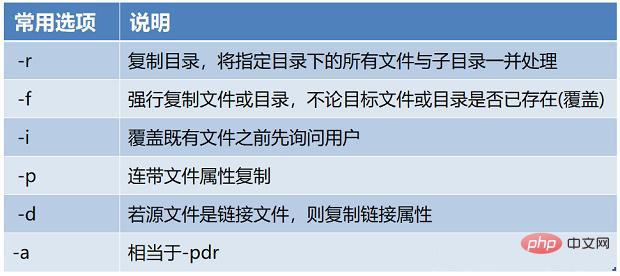
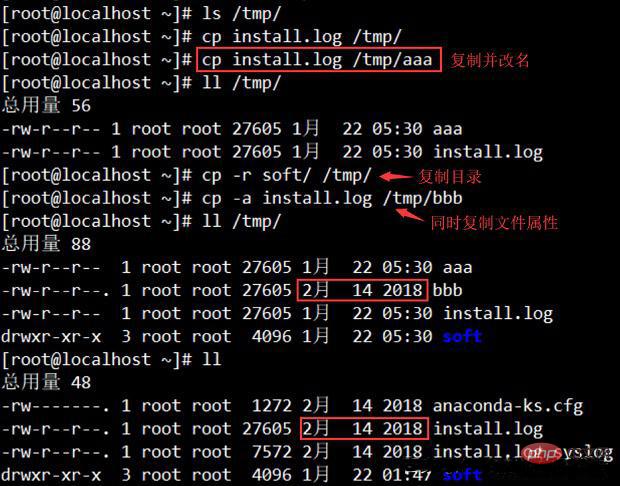
mv
move, cut or rename, if the original file and the target directory are in the same directory, it is renamed, otherwise it is cut
Syntax:
mv [原文件或目录] [目标目录]
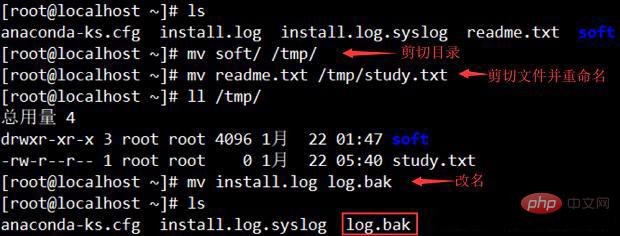
rm
remove, delete a file or directory
Syntax:
rm -rf [文件或目录]
Options: -r delete directory; -f force
It is best to be careful with this command
rmdir
remove empty directories, delete empty directories (Rarely used)
Syntax:
rmdir [目录]
The above is the detailed content of Commonly used linux commands. For more information, please follow other related articles on the PHP Chinese website!

Hot AI Tools

Undress AI Tool
Undress images for free

Undresser.AI Undress
AI-powered app for creating realistic nude photos

AI Clothes Remover
Online AI tool for removing clothes from photos.

ArtGPT
AI image generator for creative art from text prompts.

Stock Market GPT
AI powered investment research for smarter decisions

Hot Article

Hot Tools

Notepad++7.3.1
Easy-to-use and free code editor

SublimeText3 Chinese version
Chinese version, very easy to use

Zend Studio 13.0.1
Powerful PHP integrated development environment

Dreamweaver CS6
Visual web development tools

SublimeText3 Mac version
God-level code editing software (SublimeText3)
 How to process in Linux Linux FIFO scheduling policy
Sep 03, 2025 pm 12:39 PM
How to process in Linux Linux FIFO scheduling policy
Sep 03, 2025 pm 12:39 PM
To make Linux processes run in real-time FIFO scheduling, you need to use the chrt command or sched_setscheduler system call to set the scheduling policy and priority, such as sudochrt-f99./app or configure SCHED_FIFO and priority parameters in the C program, and ensure that the process has CAP_SYS_NICE capability or root permissions, and configure rtprio and memlock restrictions through limits.conf to ensure real-timeness and avoid priority reversal. You need to use a mutex that supports priority inheritance.
 Aisi Assistant's genuine download portal_Aisi Assistant's iPhone installation link
Sep 16, 2025 am 11:30 AM
Aisi Assistant's genuine download portal_Aisi Assistant's iPhone installation link
Sep 16, 2025 am 11:30 AM
The official download portal of Aisi Assistant is located on the official website https://www.i4.cn/, and provides computer and mobile downloads, supporting device management, application installation, mode switching, screen projection and file management functions.
 How to install deb format software packages for Linux
Sep 03, 2025 pm 12:36 PM
How to install deb format software packages for Linux
Sep 03, 2025 pm 12:36 PM
Common methods for installing .deb packages include: using the dpkg command to install and use apt to repair dependencies; 2. It is recommended to use aptinstall./package_name.deb to automatically handle dependencies; 3. You can double-click the file to install through the software center in a graphical way; 4. After installation, you can use dpkg-l or dpkg-s to check the package status.
 How to run Windows programs on Linux
Sep 18, 2025 am 03:25 AM
How to run Windows programs on Linux
Sep 18, 2025 am 03:25 AM
TorunWindowsprogramsonLinux,trythesemethods:1.UseWinetodirectlyrun.exefiles.2.InstallPlayOnLinuxforeasierWinemanagement.3.SetupaWindowsvirtualmachinewithVirtualBox.4.UseLutristoinstallandrunWindowsgamesseamlessly.
 Huawei HarmonyOS 6 system cancels the 'NEXT' suffix: It will be native Hongmeng in the future
Sep 24, 2025 pm 04:12 PM
Huawei HarmonyOS 6 system cancels the 'NEXT' suffix: It will be native Hongmeng in the future
Sep 24, 2025 pm 04:12 PM
The latest news on September 18th, Huawei HarmonyOS6 has launched multiple rounds of preview version push for developers, and has recently opened the experience qualification to some users who have tried it out for the first time. According to user feedback, the current system name no longer displays the "NEXT" suffix, and it is officially renamed to HarmonyOS6.0. Huawei initially proposed the name HarmonyOSNEXT for the first time at the developer conference in August 2023, aiming to mark the Hongmeng system entering a new stage of development and realizing true native self-development. HarmonyOSNEXT's most core breakthrough is to completely adopt the underlying system architecture developed independently, completely remove the Linux kernel and Android AOSP code, and only run applications based on the HarmonyOS kernel.
 How to Manage Users and Groups on a Linux System
Sep 05, 2025 am 08:01 AM
How to Manage Users and Groups on a Linux System
Sep 05, 2025 am 08:01 AM
Create user with adduser or useradd, 2. Modify user with usermod, 3. Delete user with deluser or userdel, 4. Create group with groupadd, 5. Add user to group with usermod-aG, 6. Remove user with gpasswd-d from group, 7. Delete group with groupdel, 8. View information with whoami, groups, getent and other commands, 9. Follow best practices such as avoiding direct use of root, regularly cleaning accounts, setting password policies, and reasonably allocating group permissions. By mastering these core commands and selecting appropriate tools according to the distribution, the management of Linux users and groups can be effectively realized.
 How to take a screenshot on Linux
Sep 15, 2025 am 03:35 AM
How to take a screenshot on Linux
Sep 15, 2025 am 03:35 AM
TotakescreenshotsonLinux:1.UsePrtScnkeyforfullscreen,Alt PrtScnforactivewindow.2.UseGNOMEScreenshottoolformoreoptions.3.Usegnome-screenshotcommandinterminal.4.Installandusescrotforlightweightcommand-linecapturing.
 How to find the path of a program in Linux
Sep 16, 2025 am 08:56 AM
How to find the path of a program in Linux
Sep 16, 2025 am 08:56 AM
Tolocateaprogram'sinstallationpathonLinux,use:1.whichprogram_nameforquickPATH-basedlookup.2.whereisprogram_nametofindbinaries,manpages,andsources.3.locatewithupdatedbandgrepforfastfilesearches.4.find/-typef-executable-name"program_name"fort





